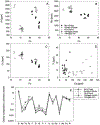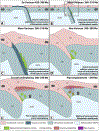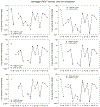Sulfur and metal fertilization of the lower continental crust
- PMID: 32908321
- PMCID: PMC7477817
- DOI: 10.1016/j.lithos.2015.11.028
Sulfur and metal fertilization of the lower continental crust
Abstract
Mantle-derived melts and metasomatic fluids are considered to be important in the transport and distribution of trace elements in the subcontinental lithospheric mantle. However, the mechanisms that facilitate sulfur and metal transfer from the upper mantle into the lower continental crust are poorly constrained. This study addresses this knowledge gap by examining a series of sulfide- and hydrous mineral-rich alkaline mafic-ultramafic pipes that intruded the lower continental crust of the Ivrea-Verbano Zone in the Italian Western Alps. The pipes are relatively small (< 300 m diameter) and primarily composed of a matrix of subhedral to anhedral amphibole (pargasite), phlogopite and orthopyroxene that enclose sub-centimeter-sized grains of olivine. The 1 to 5 m wide rim portions of the pipes locally contain significant blebby and disseminated Fe-Ni-Cu-PGE sulfide mineralization. Stratigraphic relationships, mineral chemistry, geochemical modelling and phase equilibria suggest that the pipes represent open-ended conduits within a large magmatic plumbing system. The earliest formed pipe rocks were olivine-rich cumulates that reacted with hydrous melts to produce orthopyroxene, amphibole and phlogopite. Sulfides precipitated as immiscible liquid droplets that were retained within a matrix of silicate crystals and scavenged metals from the percolating hydrous melt, associated with partial melting of a metasomatized continental lithospheric mantle. New high-precision chemical abrasion TIMS U-Pb dating of zircons from one of the pipes indicates that these pipes were emplaced at 249.1 ± 0.2 Ma, following partial melting of lithospheric mantle pods that were metasomatized during the Eo-Variscan oceanic to continental subduction (~420-310 Ma). The thermal energy required to generate partial melting of the metasomatized mantle was most likely derived from crustal extension, lithospheric decompression and subsequent asthenospheric rise during the orogenic collapse of the Variscan belt (< 300 Ma). Unlike previous models, outcomes from this study suggest a significant temporal gap between the occurrence of mantle metasomatism, subsequent partial melting and emplacement of the pipes. We argue that this multi-stage process is a very effective mechanism to fertilize the commonly dry and refractory lower continental crust in metals and volatiles. During the four-dimensional evolution of the thermo-tectonic architecture of any given terrain, metals and volatiles stored in the lower continental crust may become available as sources for subsequent ore-forming processes, thus enhancing the prospectivity of continental block margins for a wide range of mineral systems.
Figures























References
-
- Arevalo R Jr; McDonough WF; Piccoli PM (2011): In Situ Determination of First-Row Transition Metal, Ga and Ge Abundances in Geological Materials via Medium-Resolution LA-ICP-MS. Geostandards and Geoanalytical Research v. 35, no. 2, pp. 253–273.
-
- Jochum KP, Nohl U, Herwig K, Lammel E, Stoll B, and Hofmann AW, 2005, GeoReM: A New Geochemical Database for Reference Materials and Isotopic Standards: Geostandards and Geoanalytical Research, v. 29, p. 333–338.
-
- Norman MD, Griffin WL, Pearson NJ, Garcia MO, and O’Reilly SY, (1998): Quantitative analysis of trace element abundances in glasses and minerals: a comparison of laser ablation inductively coupled plasma mass spectrometry, solution inductively coupled plasma mass spectrometry, proton microprobe and electron microprobe data: Journal of Analytical Atomic Spectrometry, v. 13, p. 477–482.
-
- McDonough WF; Sun SS (1995): The composition of the Earth. Chemical Geology, v. 120, no. 3, pp. 223–253.
-
- Adam J, and Green T, 2006, Trace element partitioning between mica- and amphibole-bearing garnet lherzolite and hydrous basanitic melt: 1. Experimental results and the investigation of controls on partitioning behaviour: Contributions to Mineralogy and Petrology, v. 152, p. 1–17.
Grants and funding
LinkOut - more resources
Full Text Sources
Miscellaneous
